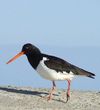Genus Haematopus

Blackish Oystercatcher - It is found in Argentina, Chile, the Falkland Islands and Peru, and is a vagrant to Uruguay.
American Black Oystercatcher - The American Black Oystercatcher is the only representative of the oystercatcher family over most of its range, overlapping slightly with the American Oystercatcher on the coast of Baja California. Within its range it is most commonly referred to as the Black Oystercatcher, although this name is also used locally for the Blackish Oystercatcher and the African Black Oystercatcher. Its scientific name is derived by John James Audubon from that of his friend John Bachman.
Chatham Oystercatcher - This species is endangered, and has a current population of 310 to 325 birds . The main threat is from introduced predators.
South Island Oystercatcher - Easily identifiable as a pied oystercatcher – a large wader with striking black and white plumage, long red-orange bill and red legs. Distinguish from pied morph of Variable Oystercatcher by white lower back, more white on wing and demarcation line of black and white on breast further forward. Distinguish from Pied Oystercatcher by longer bill and shorter legs as well as forward demarcation line of white on back being pointed rather than square. Measurements: length 46 cm; wingspan 80-86 cm; weight 550 g.
Sooty Oystercatcher - All of its feathers are black. It has a red eye, eye ring and bill, and pink legs.
Magellanic Oystercatcher - The Magellanic Oystercatcher is a species of wader in the Haematopodidae family. It is found in Argentina, Chile and the Falkland Islands. Its natural habitats are freshwater lakes and sandy shores.
Pied Oystercatcher - The name "oystercatcher" is something of a misnomer for this species, because they seldom eat oysters, which are found mainly on rocky coastlines. Pied Oystercatchers frequent sandy coastines, where they feed mainly on bivalve molluscs, which are prised apart with their specially adapted bill.
Haematopus meadewaldoi - Hockey showed that the Canarian Black Oystercatcher was a good species distinct from the African Black Oystercatcher Haematopus moquini, of which it was formerly considered a subspecies; these two were occasionally lumped as subspecies of the Eurasian Oystercatcher. Though this bird was known to naturalists since long, it was considered a mere local population of the African Black Oystercatcher until 1913 .
African Black Oystercatcher - The African Black Oystercatcher is a large and noisy plover-like bird, with completely black plumage, red legs and a strong broad red bill used for smashing or prying open molluscs such as mussels, or for finding earthworms. The sexes are similar in appearance, but juveniles are browner than adults.
Oystercatcher - This oystercatcher is the national bird of the Faroe Islands, where it is called tjaldur.
American Oystercatcher - The American Oystercatcher is found on the Atlantic coast of North America from New England to northern Florida, where it is also found on the Gulf coast, and south to northern South America. It is found also in the Pacific coast of Mexico, Central America and northern South America. In the 1800s they became locally extinct in the northeast due to market hunting and egg collecting. After receiving protection under the Migratory Bird Treaty Act, their range extended northward to re-occupy historical habitat in New England.
Variable Oystercatcher - "Variable" refers to the frontal plumage, which ranges from pied through mottled to all black. They are polymorphic meaning they have different genetic variants. They can open a shellfish by either hammering a hole in it or getting the bill between the two shells and twisting them apart. They breed in North Island, South Island, Stewart Island, and Chatham Islands. They do not breed inland or beside rivers although the SIPO does.










